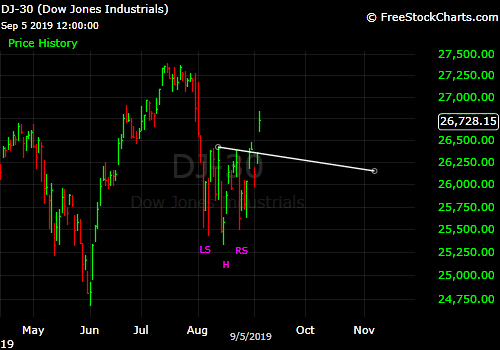After a month of very murky market activity, there is finally an upside breakout, and on the Dow Industrials, this appears to be from a Head and Shoulders pattern.

Based on the distance between the head and the neckline, the pattern implies a rally to 27,440 – 27,480 before the next significant pullback occurs.
For my Elliott Wave count, I am using the NASDAQ-100 index.

We are entering a very bullish phase for the market, as we appear to be in the third wave of three different degrees. I expect the rally off the Aug 5 low to at least equal the rally from the June 3 low to the July 26 high, and an aggressive target would be a 1.618 Fibonacci relationship. This gives us the following target ranges (each range spans from point-basis target to percentage-basis target):
Conservative: 8430 – 8495
Aggressive: 9093 – 9198
The percent rally projected from current levels, spanning most conservative to most aggressive, is 7.2% – 17.0%.
As I described in my post last month, we have a technical situation now that looks a lot like 2011-2012. We are at the point now where we were in late-2012, and 2013 turned out to be a very bullish year, which took many by surprise given the domestic and international economic concerns that rattled the markets in 2012. During Q3-Q4 2012, annualized GDP growth had slowed to 0.5%.
The Federal Reserve began its third quantitative easing program in 2012, which may have somewhat strengthened economic growth in 2013 and eased recession fears, allowing the stock market to rise. Interestingly, at our present time, the Fed has started cutting interest rates, which could have similar effects for the economy and markets.
I think the Fed is making the right decision to do small, data-dependent rate cuts, rather than commit to a rate cut cycle. Economic growth in the U.S. will reaccelerate when the U.S.-China trade war ends (or substantial progress is made in that direction). And with strong consumer spending right now, I see inflation risk if the Fed were to cut rates too aggressively.
Regardless of the Fed’s timing on interest rates, a recession will happen eventually because it is a natural phase of the business cycle. However, if the Fed keeps inflation low, the next recession could be fairly mild. Once there is a sustained recovery from a severe recession, it is typically 25-35 years before another severe recession occurs. Thus, I don’t expect a downturn anywhere close to the Great Recession until at least the 2030s. But aggressively raising interest rates to fight inflation could lead to a moderate recession rather than a mild one.